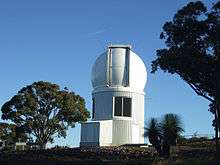SkyMapper
 | |
| Organisation | RSAA |
|---|---|
| Location(s) | Siding Spring Observatory |
| Coordinates | 31°16′24″S 149°03′52″E / 31.2733°S 149.0644°ECoordinates: 31°16′24″S 149°03′52″E / 31.2733°S 149.0644°E |
| Altitude | 1,163 m (3,816 ft)[1] |
| Wavelength | 325–969 nm[1] |
| Built | November 2007 |
| First light | 2008 |
| Telescope style | Modified Cassegrain |
| Diameter | 1.35 m (4.4 ft) |
| Angular resolution |
1.1″ median seeing limit 0.5″ pixel size[1] |
| Collecting area | 1.16 m2 (12.5 sq ft) |
| Focal length | 6.2 m (20 ft) |
| Mounting | altitude/azimuth |
| Enclosure | 11.5 m tall, 6.25 m dia |
| Website |
www |
SkyMapper is a fully automated 1.35 m (4.4 ft) wide-angle optical telescope at Siding Spring Observatory in northern New South Wales, Australia. It is one of the telescopes of the Research School of Astronomy and Astrophysics of the Australian National University (ANU). The telescope has a compact modified Cassegrain design with a large 0.69 m secondary mirror, which gives it a very wide field of view: its single, dedicated instrument, a 268-million pixel imaging camera, can photograph 5.7 square degrees of sky. The camera has six light filters which span from ultraviolet to near infrared wavelengths.
The SkyMapper telescope was built to carry out the Southern Sky Survey, which will image the entire southern sky several times over in SkyMapper's six spectral filters over the course of five years. This survey will be analogous to the Sloan Digital Sky Survey of the Northern hemisphere sky. It has several enhancements, including temporal coverage, more precise measurements of stellar properties and coverage of large parts of the plane of the Galaxy.
The telescope and its camera were built by the ANU as a successor to the Great Melbourne Telescope at Mount Stromlo after that telescope was burnt in the 2003 Canberra bushfires. It was inaugurated by Minister Kim Carr and Governor of New South Wales Marie Bashir in 2009.[2] The survey project is funded by the Australian Research Council through various grants.[3][4] The project was also a finalist in The Australian's 2011 Innovation Challenge.[5]
Telescope


.jpg)
The telescope and its dome were built by Electro Optics Systems of Canberra. As the telescope has an alt-azimuth mounting, its dome is compact and snug: the minimum clearance as the telescope moves is about 4 cm.
Camera and filters
The camera is a tiled mosaic of 32 CCD chips, each with 2k x 4k pixels, arranged in a 4 x 8 array.[6]
The six filters used to take observations are set in a photometric system partly similar to that of the Sloan survey, to aid in comparison of the two sets of observations. These similar filters are the visible and near-infrared passbands named g, r, i and z. SkyMapper has additional, distinctive ultraviolet filters, a Strömgren system-like u, and a unique narrow v near 4000Å.[7] These two filters bracket the Balmer jump of stars' spectra, and allow the survey to detect the population of metal-poor stars within the Milky Way.[1]
Data
The stars, galaxies and asteroids observed in the survey (expected to be about a billion) will be extracted from each image and made publicly available via an Internet query form. The main dataset of the survey will be stored and processed at the ANU supercomputing facility.[8]
The star SMSS J031300.36-670839.3, one of the oldest known stars in the Universe, was discovered by a team led by Australian National University astronomers in early 2014.[9]
References
- 1 2 3 4 Keller, S. C.; Schmidt, B. P.; Bessell, M. S.; Conroy, P. G.; Francis, P.; Granlund, A.; Kowald, E.; Oates, A. P.; Martin-Jones, T.; Preston, T.; Tisserand, P.; Vaccarella, A.; Waterson, M. F. (2007-05-04). "The SkyMapper Telescope and The Southern Sky Survey" (PDF). Publications of the Astronomical Society of Australia. 24 (1): 1–12. arXiv:astro-ph/0702511
 . Bibcode:2007PASA...24....1K. doi:10.1071/AS07001. Retrieved 2008-03-25.
. Bibcode:2007PASA...24....1K. doi:10.1071/AS07001. Retrieved 2008-03-25. - ↑ Miller, Barbara (25 May 2009). "SkyMapper telescope to explore southern sky". ABC PM. Retrieved April 17, 2012.
- ↑ Herrick, Chloe (4 November 2011). "ANU awarded research grant for Skymapper telescope". Computerworld. Computerworld. Retrieved April 17, 2012.
- ↑ "Nobel Laureate Brian Schmidt gets $1m cash boost to map southern sky". Herald Sun. AAP. 30 March 2012. Retrieved April 17, 2012.
- ↑ The Australian (October 29, 2011). "Finalist Stefan Keller: Skymapper telescope". The Australian. The Australian. Retrieved April 17, 2012.
- ↑ Granlund, A.; Conroy, P. G.; Keller, S. C.; Oates, A. P.; Schmidt, B.; Waterson, M. F.; Kowald, E.; Dawson, M. I. (July 2006). "A large-format imager for the SkyMapper Survey Telescope". In McLean, Ian S.; Iye, Masanori. Ground-based and Airborne Instrumentation for Astronomy. 6269. Proceedings of the SPIE. p. 626927. Bibcode:2006SPIE.6269E..69G. doi:10.1117/12.670121.
- ↑ Bessell, Michael; Bloxham, Gabe; Schmidt, Brian; Keller, Stefan; Tisserand, Patrick; Francis, Paul (July 2011). "SkyMapper Filter Set: Design and Fabrication of Large-Scale Optical Filters". Publications of the Astronomical Society of the Pacific. 123 (905): 789–798. arXiv:1106.1475
 . Bibcode:2011PASP..123..789B. doi:10.1086/660849.
. Bibcode:2011PASP..123..789B. doi:10.1086/660849. - ↑ Lohman, Tim (15 June 2009). "Aussie SkyMapper Telescope to "open new windows of exploration"". CIO Magazine. Retrieved April 17, 2012.
- ↑ "Oldest known star discovered". ABC Online. 9 Feb 2014. Retrieved 9 Feb 2014.
External links
Coordinates: 35°19′09.55″S 149°00′31.78″E / 35.3193194°S 149.0088278°E